Geography Made Egypt Possible
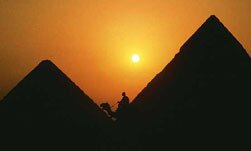 Egypt is located between two red deserts (the Eastern Desert and Western Desert), and is essentially an elongated oasis created by the Nile River. Those two geographic features, the deserts and river, are essential to understanding Egypts unique history and the physical existence of ancient Egypt. And without the Nile River, Egypt would never have existed. Egypt is located between two red deserts (the Eastern Desert and Western Desert), and is essentially an elongated oasis created by the Nile River. Those two geographic features, the deserts and river, are essential to understanding Egypts unique history and the physical existence of ancient Egypt. And without the Nile River, Egypt would never have existed.
The Nile flows for more than 4,000 miles. It begins as the Blue Nile, a river rising from Ethiopia, and the White Nile flowing from Lake Victoria, through Uganda. They unite at Khartoum and become the Nile River that flows for more than 1900 miles north to the Mediterranean Ocean.
As it flows from Khartoum, the Nile is interrupted by the famous, (6), Nile Cataracts. The 6th cataract is just north or Khartoum and the 1st cataract is at Aswan. It is from the 1st cataract northward for 750 miles the Nile flows uninterrupted through the civilization we know of as Egypt.
Upper and Lower Egypt
Egypt existed for several thousand years as two parts because of geography. For the last one hundred miles before it ends at the Mediterranean Ocean, the Nile fans out into a broad delta. It was named delta by the Greeks because it resembled the triangular shape of their letter delta. The Delta has many streams and tributaries that flow through marshy flats. The Delta is known as Lower Egypt The territory to the south is less arid and the river is bordered on both sides by tall cliffs. This part is called Upper Egypt.
Seasonal Changes
 Torrential rains in Ethiopia caused the Niles waters flood the land, Herodotus, a 5th century Greek, wrote, As the Nile River inundates the land, all Egypt is a sea, and just the towns remain above the water, making it look like the islands of the Aegean Sea. Torrential rains in Ethiopia caused the Niles waters flood the land, Herodotus, a 5th century Greek, wrote, As the Nile River inundates the land, all Egypt is a sea, and just the towns remain above the water, making it look like the islands of the Aegean Sea.
During the Inundation period, which is from June to September, peasants were busy doing the work of the pharaoh like hauling stones for his building projects.
From October to February, the Emergence period, the water receded and left behind rich, moist, black soil. Farmers diverted the waters into large retention basins to trap it for future use and channel it down the many canals dug from these basins to fields. During this time they planted their crops in the mud. In order to preserve the water, they also sank wells into the hard rock. They also build dikes to prevent the river from inundating villages.
During the Drought farmers harvested their crops, threshed it, ground it, and prepared it for storage or to sell.
Egypts Economy
The Nile was responsible for Egypts economy. If the flooding was too great, it invaded the towns and destroyed the fragile homes of the very poor. If it was too small, the life-giving water would not reach the remote areas and famine a would occur. Once the Egyptians learned how to harness the Nile and plan around its flood cycles, Egypt was on its way to becoming a nation.
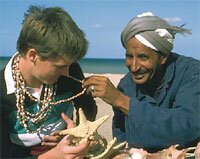 The value of land, as is still the case today in some places, was determined by how much water it got. Land that was always flooded was the most valuable and land that never received the benefits of the Nile was the least valuable. Land was taxed accordingly. Naturally, disputes occurred often over water rights. The value of land, as is still the case today in some places, was determined by how much water it got. Land that was always flooded was the most valuable and land that never received the benefits of the Nile was the least valuable. Land was taxed accordingly. Naturally, disputes occurred often over water rights.
The Nile made Egypt an agricultural nation. Egyptians never had to worry about rain, the Nile provided enough water. Egyptians never had to worry about wearing out the soil, the Nile deposited fresh black dirt each season as the flood waters receded. Grain was the chief product and when the irrigation waters were well administered, the fields yielded a bountiful harvest. Egypt almost always had crops to export.
The primary grain products in Egypt were flax, barley, emmer, castor, date palm, grapes and sesame. They raised many animals as well. Cattle, goats, pigs and sheep were grown in different parts of Egypt. In the Delta where huge expanses of marshes were lined with thickets of bulrushes, Egyptians glided silently in their reed boats to catch geese, ducks and cranes. These birds were often taken back to be fattened in pens or raised for their eggs.
One important product that Egyptians had a monopoly on until the 12th century A.D. was paper. Papyrus grew in great profusion along the banks of the Nile. Papyrus is also called bulrushes. Once the Egyptians developed a method for making fine paper from the stalk of this reed, they had an excellent commodity for export that was in high demand. Sheets of paper were vastly superior to clay tablets for keeping records and writing letters. Papyrus also could be twisted into an excellent rope and cord. Many sailing vessels of the ancient world were rigged with papyrus rope from Egypt. Small boats were made from bundles of papyrus reeds, as were numerous household items like baskets, mats, stools, and even sandals.
Oil is a necessity for all early civilizations. The Egyptians used the oil from plants they grew to meet their basic needs. Flax-seed and sesame oil was used for cooking, providing light, and for making soap.
Transportation
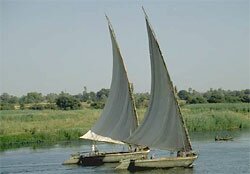 Even in transportation, the Egyptian was fortunate. In other countries where goods had to be transported overland, travel was very slow. But on the Nile, the network of tributaries formed a web a waterways that reached nearly every potential customer. Boats could drift along with the current, or rowed, or a sail could be flown to travel in the opposite direction. The Egyptians left evidence of their prowess as boatmen in their artwork in a piece of pottery dated 3200 B.C. Other artwork shows boats ranging from simple rafts to 200 foot barges for hauling obelisks and freighters for carrying produce. Artwork found in the tombs, as well as the boats themselves, depict the passage of the nobility across the waters of the afterworld. Even in transportation, the Egyptian was fortunate. In other countries where goods had to be transported overland, travel was very slow. But on the Nile, the network of tributaries formed a web a waterways that reached nearly every potential customer. Boats could drift along with the current, or rowed, or a sail could be flown to travel in the opposite direction. The Egyptians left evidence of their prowess as boatmen in their artwork in a piece of pottery dated 3200 B.C. Other artwork shows boats ranging from simple rafts to 200 foot barges for hauling obelisks and freighters for carrying produce. Artwork found in the tombs, as well as the boats themselves, depict the passage of the nobility across the waters of the afterworld.
The Age of the Pharaohs The First Dynasty
Perhaps it was the failure of rains which for centuries had made the plains of northeast Africa bountiful with wild game that forced the prehistoric ancestors of the Egyptians to follow the game and leave the plains and descend into the lower valley into the Delta of the Nile River. There, they commenced the slow conversion from a hunter-gather society to an agrarian civilization
There were 6 factors that nudged Egyptians toward food production and away from the subsistence existence of the hunter-gatherer.
- Depletion of wild animals
- The discovery and availability of domesticable wild plants
- The development of technologies for collecting, processing, and storing wild foods
- The rise in population and consequential rise in food production
- The density of populated communities enabling them to kill off the scattered hunters and gatherers
- The need to harness the floodwaters of the Nile
By about 3200 B.C., the process from man-hunter to man-farmer had begun. Upper and Lower Egypt were constantly battling over trifling problems Egyptians were at heart a peaceful and non-aggressive people. In about 3000 B.C. Menes, tribal leader of Upper Egypt, assembled an army and overwhelmed Lower Egypt.
Political System in Egypt
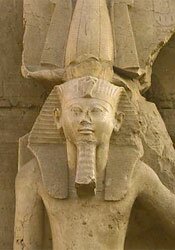 Early records tell the story of the political and religious system in ancient Egypt. It appears that Nar the warrior from Upper Egypt, conquered Lower Egypt (the delta region), and united the two countries. He declared himself god and sole, divine ruler of the land. The name he assumed was Nar the earthly name for Horus, god son of Ra. Early records tell the story of the political and religious system in ancient Egypt. It appears that Nar the warrior from Upper Egypt, conquered Lower Egypt (the delta region), and united the two countries. He declared himself god and sole, divine ruler of the land. The name he assumed was Nar the earthly name for Horus, god son of Ra.
It seems that the general good nature and peaceful temperament of Egyptians made the merging of these two countries easy and the conversion to a national government/religion fairly smooth. With the union of Upper and Lower Egypt, the people accepted the Pharaoh represented security, order, discipline, and central authority to undertake the public works that would benefit the whole society. He was the spiritual and material leader. Every Egyptian believed that the sun rose and set according to the Pharaoh's will.
The Egyptians belief in their king/god was unique. The king was not Gods emissary, or representative, or delegate. As Horus, son of the supreme deity Ra, he originally came to earth from heaven to help mankind deal with his spiritual and material life. Each new King was the incarnation of the original Horus, not a son of the old King, but son of the original God, Horus. This process was called autogeneration. The King, therefore, was the same earthly deity, unchanging from century to century, always a vital, regenerating force.
As divine ruler, it was by the will of the Pharaoh that the months followed one another, that the Nile rose and fell, that the replenishing black dirt was left to grow new crops, that people were bone and died. Everything that existed was the result of his will. He was the standard by which everything was measured.
The Organization of Egypt
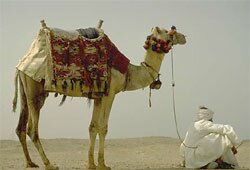 The lives of all Egyptians were blended with their religion and totally inseparable. The Pharaoh rules with divine, omniscient right. Therefore his administrators were slowly imbued with godliness as well. As they shared the ruler's power, they shared his divinity. In this way, the class system developed in Egypt. People were rich and powerful because they were godly. Because they were godly, they had a right to make decisions about the lives of the commoner. The lives of all Egyptians were blended with their religion and totally inseparable. The Pharaoh rules with divine, omniscient right. Therefore his administrators were slowly imbued with godliness as well. As they shared the ruler's power, they shared his divinity. In this way, the class system developed in Egypt. People were rich and powerful because they were godly. Because they were godly, they had a right to make decisions about the lives of the commoner.
The administration of Egypt was divided into three basic areas. The civil concerns were overseen by the vizier. He was the top manager. Other than the king himself, no person had as much power. His responsibilities included overseeing food production, building projects, artwork and crafts, the courts of justice, tax collection, all public works, the army and police force. The vizier was charged the pass judgment upon the citizens. The Egyptian view of justice was as highly evolved as it is today. The vizier was instructed to act justly, to never pass judgment on a person without letting that person explain his position. He was told never to feel anger or vengeance toward another, to act with equity and fairness and justice in all decisions, but never be a tyrant. This is quite remarkable. The vizier was usually appointed by the nobility, but could be chosen by the Pharaoh. The position sometimes passes down through one family. An another surprising idea that prevailed in Egypt was the advancement and promotion of people of ability over those of wealth. It is unclear exactly how Pharaohs were selected, and some are certainly common people who showed great ability.
The second area of administration was priesthood who managed the temples. The priests gained tremendous power over the centuries because they were given exemption from paying taxes and from contributing a portion of their farm's yield to the state. The priests also grew rich from the foreign booty offered to the temples after a military conquest. The priests conveyed to the Pharaoh and the people the approval of the god's for their offerings which, in turn, spurred more gifts and conquests by the Pharaoh. By 1000 BC, one priest had about 1/3 of the land of Egypt in his possession. Naturally, with these vast resources, the priests were eventually as powerful at the Pharaoh.
The third area of administration was the military. Until about 1450 BC, the military consisted of a feudal-like system. Egypt was divided into 40 provinces, called nomes. The governors of the nomes were called nomarchs. Each governor has total authority to govern his province and many became very wealthy. At times of war, the Pharaoh called upon his governors for soldiers. Once the conflict passed, the Pharaoh sent the men back to their provinces. However, Ahmose I undertook to oust the Hykos people from Egypt. (The Hykos people invaded Egypt from Asia in about 1785 BC and ruled for over 300 years.) He was successful and became Pharaoh, establishing a standing professional army that provided opportunities for men of valor to excel in the Pharaoh's administration once he left the service. One such man was Amenhotep-son-of-Hapu who became vizier and constructed two 70 foot statues of Pharaoh Amenhotep III in the Theban Necropolis. He also was permitted to erect several statues in the temple of Karnak featuring himself as the royal script sitting on the ground. He was also allowed to erect a mortuary temple for himself and his family of tremendous size next to the royal temples of Thebes.
Life in Egypt
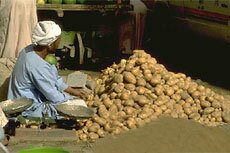 Slaves were at the bottom of the social class in Egypt. Hundreds of thousands of slaves were brought to Egypt from conquered lands and were put to work at all form of tasks. The worse jobs were in the mines where men were worked to death, usually because of being deprived of enough water to survive in the intense heat. Some slaves were put into the military, put to work on estates, and the in the homes of royalty. The children of some who showed talent were sometimes able to move up in the administration and secure a place for themselves in Egyptian society. Slaves were at the bottom of the social class in Egypt. Hundreds of thousands of slaves were brought to Egypt from conquered lands and were put to work at all form of tasks. The worse jobs were in the mines where men were worked to death, usually because of being deprived of enough water to survive in the intense heat. Some slaves were put into the military, put to work on estates, and the in the homes of royalty. The children of some who showed talent were sometimes able to move up in the administration and secure a place for themselves in Egyptian society.
Peasants were abundant in Egypt. In spite of the large bureaucracy, the vast majority of people were peasants. They worked their farms or toiled, took care of cattle, or worked at unskilled jobs . The peasant had a clear understanding of the rhythm of his life, and expected little to change. The flood season offered the peasant some diversion because the priests would put on religious festivals and landlords might have offered feasts to the peasants. Although the peasant was poorer than the craftsman, at times of want, the peasant was usually better able to feed himself than the carpenter or painter. Today, peasants live in much the same way.
The Egyptians were exacting record keepers. The entire government ran on taxes, and these had to be recorded and maintained. Scribes, trained at youth, mainly from the near royalty class, were employed all over Egypt and their records remain to tell their story even today. Scribes began their training at 5 years old and endured long days of practice and corporal punishment. Because the scribe was employed by the nobility and managed financial transactions, they had the opportunity to both move into royal society and to skim a certain percentage of the profits.
In Egypt, a craftsman was usually better off than the peasant farmer.
|
|

Click here to download an Acrobat PDF version of this page for printing.
|







